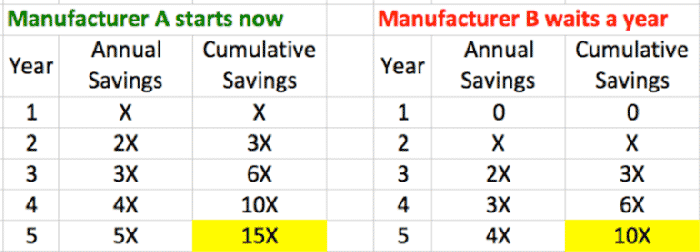5 Pitfalls of Not Transitioning to Smart Manufacturing Now5 Pitfalls of Not Transitioning to Smart Manufacturing Now
Most North American and European manufacturers are looking at ever-increasing competition and shrinking margins. Certainly, systems that will improve performance, consistency, and quality sound appealing. But the feeling is often: Is now the right time? Can we afford to? Why today?
August 27, 2016

By Andrew Waycott
I’ll give you five reasons why today is the right time. And just for fun, I’ve given you the most convincing argument last – wait for it!
1. Because Your Competitors Are
Your competitors, local and global, are increasingly moving to smart manufacturing. This allows them to offer better pricing (or generate higher profitability) than you, as well as deliver improved quality.
It’s considerably harder to play catch-up than to stay apace. Once you get truly behind, catching up gets that much harder. Not to mention, at one point it will become necessary to stay in the game – there will be a day when you’ll be precluded from bidding if you don’t have a smart manufacturing system.
2. Stop Throwing Your Money Away
Every month you wait, you’ve foregone the savings you could have generated that month. And you can never get that month’s savings back. The sooner you move to smart manufacturing, the sooner you start earning monthly savings against your original investment. You’re going to have to make the investment. The sooner you do it, the sooner you start generating savings.
And let’s not forget, there’s always the cultural component. It takes time to turn a company culture – just as it takes time to turn a big ship. You can nudge and encourage this process, but you can’t skip it. There is no instant bandwagon.
3. It Keeps Getting Cheaper
Technology tends in drop in cost for both software and hardware. Both have dropped significantly for smart manufacturing. Sensors and data/memory costs have plummeted. Platforms are more abundant, more reasonable, and more flexible – they’re no longer one (large) size fits all.
There are those who try to figure out the ideal time to make your move – that is, when potential savings perfectly offset dropping costs. However! It’s tough to be absolutely accurate, given the human factor, and the unknowns. I’d argue that further reductions in costs are not going to be enough to offset the monthly savings you can generate.
I encounter, regularly, plant managers who claim that they are better off waiting because they can do internally, at lower cost, some of what companies like Factora offer. And in theory, they can. But in practice, they’ve been trying and failing for years. Not to mention, speed is a critical factor. And every month of savings they lose can never be recovered …
4. Increased Consistency Drives Profitability
The more consistent you are, the more attractive you are to new prospects. And to your current customers, whom you want to retain.
Typically, the most attractive customers will pay a premium for consistency, or will choose a producer who can offer consistent quality over one who offers lower consistency and slightly lower prices. And the only way to get to greater consistency, the only realistic, reasonable way, is through smart manufacturing.
There is typically a heavy price to pay for low consistency or inconsistent quality—daily, in terms of waste, and occasionally, in terms of serious, costly errors.
5. Cumulative Savings
Some manufacturing investments yield a relatively fixed saving. You invest in X – you get Y back, every year. At a certain point, you’ve broken even.
Smart manufacturing savings are better because the system allows you to continually improve. You not only continue to generate, annually, the savings you discovered in the first year – you find new, additional savings every year.
Let’s make a very simple model to illustrate this. Let’s say Company A starts this year, and Company B waits a year. And let’s say Company A generates X savings in the first year, from Project 1, and then 2x in the second (Project 1 savings plus Project 2’s), and so on. After five years, how much greater are Company A’s savings than Company B’s?

The answer? It might surprise you. Five years from now, Company A has generated 15X in savings, 50% more than Company B.
The time is now.
You May Also Like
.jpg?width=700&auto=webp&quality=80&disable=upscale)





